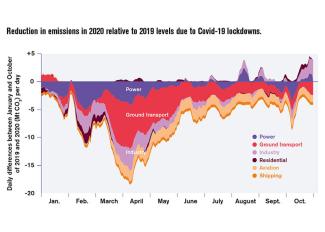Climate protection
UNEP sees climate opportunities in pandemic-related stimulus

UNEP reckons that global carbon emissions went down by seven percent in 2020 because of the Covid-19 pandemic’s impacts on industrial production, energy use and transport. However, this temporary reduction will only have a tiny impact on the global climate. According to UNEP, it will make global temperatures rise by 0.01° Celsius less by 2050 than would otherwise have been the case.
Post-pandemic reconstruction, by contrast, offers serious climate-protection opportunities. The authors of UNEP’s Emissions Gap Report 2020 estimate that billions worth of stimulus spending can reduce expected emissions by up to one quarter if governments opt for supporting green investments. Prudent choices, they point out, would do a lot to keep global temperatures from rising by more than 2°, the declared limit set by the Paris Agreement. For that purpose, support must be channelled to climate-friendly technologies and infrastructures. At the same time, subsidies for fossil fuels must be cut and no additional coal-fired power plants may be built.
Unfortunately, things so far do not look good, according to the report. Only five of the G20 nations have earmarked a share of their Covid-related spending for reducing emissions. The G20 together account for about 78 % of global carbon emissions. The UNEP experts regret that most subsidies promote carbon-intensive business as usual. Given that it is still possible to change course, they want governments to grasp climate-protection opportunities in their next stimulus programmes.
The Paris Agreement on Climate Change, which was concluded by the international community in 2015, states that global warming must be limited to 2° at most and, if possible, to a mere 1.5°. The annual UNEP Emissions Gap Report serves to assess the gap between estimated future greenhouse-gas emissions if countries implement their climate pledges and emission levels needed to achieve the Paris goals.
At current trends, UNEP expects global temperatures to increase by more than 3° in the course of the century.
The share of carbon molecules in the atmosphere is said to have risen for the third consecutive year in 2019. That year, global carbon emissions increased by 2.6 %, the report states, and amounting to an unprecedented 59 gigatonnes. The annual increase of greenhouse-gas emissions since 2010 was 1.4 %. According to UNEP, huge forest fires were the main reason why the trend accelerated in 2019.
On the upside, the experts appreciate that an increasing number of countries have announced the intention to make their economies carbon-neutral by mid-century. When they finalised the document, 126 national governments had either adopted such policies, declared that goal or at least begun to consider taking that step. The authors consider this an important and encouraging development.
Insufficient commitments
Now tangible action is needed, they insist: pledges to achieve carbon neutrality must translate into more stringent nationally determined contributions (NDCs) towards achieving the goals of the Paris Agreement. The ambitions spelled out in the NDCs so far do not suffice, the authors warn. To stay within the 2° limit, three times more must happen than pledged so far, and to stay within the 1.5° limit, even five times more is needed. Under the Paris Agreement, countries were obliged to update their NDCs in 2020, but many did not do so in time. The formal deadline was nine months ahead of the annual UN climate summit, which was supposed to take place in Glasgow at the end of 2020. Due to the pandemic, it was postponed by one year.
Link
UNEP: Emissions Gap Report 2020.
https://www.unenvironment.org/emissions-gap-report-2020













